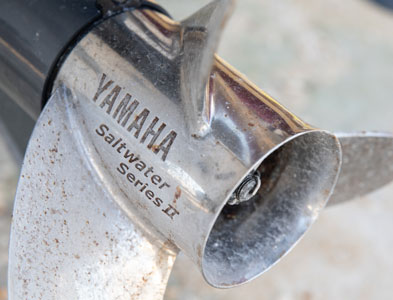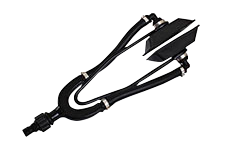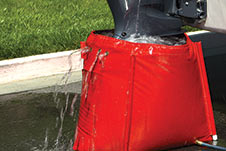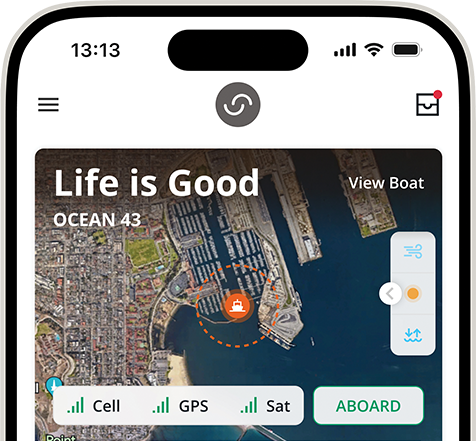Corrosion Prevention
DEFEND AGAINST THE ELEMENTS
While your Yamaha Marine dealer can help you with, or even do, most of your general and preventative maintenance, corrosion mitigation is something you can only do yourself—and time is of the essence.
Regardless of where you boat, corrosion attacks both the inside and the outside of your outboard engine—every day, all the time.
Some forms you can see, some you can’t, and it can take only a short time for the damage to begin. Even those boating in freshwater have corrosion-mitigation duties to attend to. Even rainwater can have corrosive effects that can be damaging to your outboard. It’s vital to be diligent in your anti-corrosion defense.
Your dealer can help provide the right products to help prevent some forms of corrosion, but their regular and diligent use is strictly up to you.

FIGHT OFF CORROSION
Corrosion can happen pretty much anywhere on or in your outboard: inside, in your fuel system or in the internal cooling water passages, and on the outside, in various electrical connections and exposed metal components.
Dry corrosion occurs in areas not in direct contact with water—exhaust systems, for example. The outside of most exhaust system components is cooled by raw water to prevent overheating. When today’s ethanol-enhanced fuel is burned, it creates by-products known as sulfate salts. These salts are highly corrosive, especially when exposed to very hot temperatures.
If the outboard’s cooling water passages are not kept clean by regular fresh water flushing (the exhaust area in this example), hot spots can form on the interior of the exhaust components, concentrating the sulfate salts’ corrosive effects.
In effect, it’s corrosion from the inside out. That’s why flushing your engine with fresh, clean water for 15 minutes after each trip is a vital part of preventing even dry corrosion. It helps the cooling system run at maximum efficiency by keeping the cooling water passages clean and clear, which helps minimize the heat inside the engine, making it less susceptible to dry corrosion.
It’s a good practice to set up a regular schedule and stick to it. There are quick and simple things you should do after every use if you boat in saltwater, and periodically if freshwater is your game. These include visual inspections you should do every time. If you’re unsure about what to do and when, your authorized Yamaha Marine dealer can help.
FLUSHING METHODS
Your Yamaha outboard is raw-water cooled, meaning it uses the water it’s operating on as cooling water. All water, fresh or salt, contains contaminants that will eventually build up in the cooling passages over time.
Additionally, saltwater is naturally corrosive and any remaining in those cooling water passages after use is left there to do its worst, unabated. Saltwater can also experience crystallization when exposed to heat above 170 degrees, which causes deposits to form and potentially restrict cooling water passages. For these reasons, it’s a must that you flush your engine thoroughly with fresh, clean water after every use.

This is the most common and often-used fresh water flushing method. Here’s how it works:
- Simply connect a garden hose to clean, fresh water on one end and a “flush muff” attachment, which slides around the lower unit to provide water to both sides of the raw water inlet, to the other end.
- Turn on the water until you see water squirting out the sides of the flush muff, then start your outboard in neutral.
- Set the outboard to no more than a fast idle (900-RPM max) and allow to run for 15 minutes in neutral. Increase hose water pressure enough to maintain a bit of squirting out from under the flush muffs at all times while the outboard is running. This helps ensure it gets fed enough cooling water.
Tip: Increasing engine speed may cause water demand to exceed supply. If you notice the hose becoming flat while the outboard is running using this procedure, increase the water flow and/or decrease the engine RPM.
Warning: For safety, we suggest you remove the propeller before you begin. Accidental engagement of the outboard into gear with the outboard running will cause an exposed propeller to spin rapidly, possibly resulting in serious injury or death.

This outboard flushing bag method can be used for a boat on a trailer or when moored. A flush bag, when filled with water, simulates the outboard idling in its normal state but immerses the lower unit in fresh, clean tap water. Here’s how it works:
- Simply place the bag around the outboard, attach the hose and fill the bag. Ensure the water level reaches the height of the outboard’s water pump (about 1” above the lower unit separation seam).
- Start the engine, and run for 15 minutes in neutral. Leave the hose running during this entire procedure.
- When complete, stop the outboard, then the hose and then drain the bag.
- Thoroughly dry the bag before storage.
This is a great procedure to follow, especially if you can’t remove your boat from the water, or if your outboard has dual water inlets and you don’t have the special adapter. Here’s how it works:
- Simply connect a garden hose to the inlet side of your non-running outboard’s built-in flush attachment, turn the spigot on full blast, and let the hose’s water pressure do the work.
- Let the water run for 15 minutes to ensure it fully circulates through the entire cooling system several times. If your boat’s out of the water, like on a trailer or a lift, the fresh water will also trickle down and adequately clean the water pump and the lower unit’s cooling water passages.
Videos

Yamaha - Freshwater Outboard Flushing with Steve Pennaz

Preventive Outboard Maintenance

Yamaha Boating Tip - Yamashield

Cleaning Your Propeller Pt. 1
Your boat and outboard at your fingertips.
 The Siren Connected Boat App
The Siren Connected Boat App
Dealer-completed service. DIY maintenance. Track it all with the Siren Connected Boat app. It puts a full maintenance history at your fingertips. Plus, you can remotely monitor and control critical boat systems and security, and more when properly equipped.